
Prostanthera calycina, the West Coast mintbush, limestone mintbush or red mintbush, is a species of flowering plant that is endemic to the Eyre Peninsula in South Australia. It is a small, more or less prostrate shrub with aromatic, elliptic to oblong leaves and red flowers.

Prostanthera eurybioides, commonly known as Monarto mintbush, is a species of flowering plant in the family Lamiaceae and is endemic to the south-east of South Australia. It is a low, spreading shrub with densely hairy branches, thick, elliptic to egg-shaped leaves clustered on short shoots, and violet to mid-purple flowers that are white with orange and dark purple dots inside the petal tube.

Prostanthera nivea, commonly known as snowy mint-bush, is a species of flowering plant in the family Lamiaceae and is endemic to eastern Australia. It is a shrub with linear to cylindrical leaves and white flowers arranged in leaf axils near the ends of branchlets and is one of the mint-bushes that is not aromatic.

Prostanthera stenophylla is a species of flowering plant in the family Lamiaceae and is endemic to Wollemi National Park in New South Wales. It is an erect, slender, aromatic shrub with hairy, oblong leaves and small groups of pale bluish mauve to violet flowers.
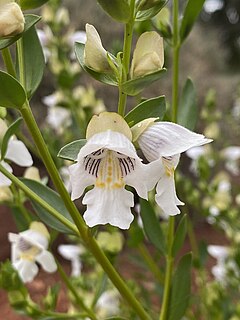
Prostanthera striatiflora, commonly known as jockey's cap, striated mintbush or striped mintbush, is a species of flowering plant that is endemic to the more arid areas of Australia. It is an erect, aromatic shrub with narrow egg-shaped to narrow elliptic leaves and white flowers with purple lines inside the petal tube.

Prostanthera walteri, commonly known as blotchy mint-bush, is a species of flowering plant that is endemic to south-eastern Australia. It is a sprawling shrub with tangled, hairy branches, egg-shaped leaves and usually bluish green flowers with prominent purple veins arranged singly in leaf axils.
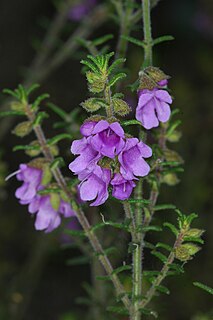
Prostanthera decussata, commonly known as dense mintbush, species of flowering plant that is endemic south-eastern Australia. It is a dense, compact, strongly aromatic shrub with egg-shaped leaves and mauve to violet flowers with yellow streaks, arranged in leaf axils near the ends of branchlets.
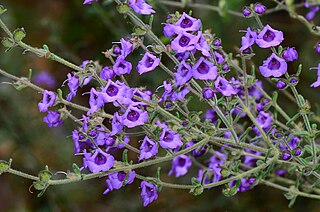
Prostanthera hirtula, commonly known as hairy mintbush, is a species of flowering plant in the family Lamiaceae and is endemic to the south-eastern continental Australia. It is a strongly aromatic, densely hairy, spreading shrub with narrow egg-shaped leaves and dark mauve flowers, and that grows in exposed, rocky sites.
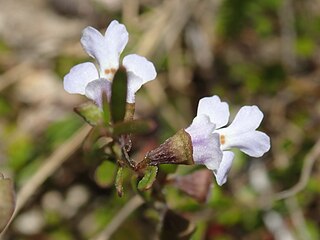
Prostanthera junonis, commonly known as Somersby mintbush, is a species of flowering plant in the family Lamiaceae and is endemic to the Central Coast of New South Wales. It is a low, straggling shrub with hairy, egg-shaped leaves and purple to mauve flowers.

Prostanthera althoferi is a species of flowering plant in the family Lamiaceae and is endemic to inland areas of Australia. It is an erect shrub with its stems and leaves densely covered with silvery, greyish-green hairs, and has narrow egg-shaped leaves and white to cream-coloured flowers with mauve or purple striations inside.

Prostanthera ammophila, commonly known as sand mintbush, is a species of flowering plant in the family Lamiaceae and is endemic to southern areas of South Australia. It is an erect to spreading shrub with egg-shaped to narrow elliptical leaves and white and purple to mauve flowers with yellow spots inside.

Prostanthera baxteri is a species of flowering plant in the family Lamiaceae and is endemic to the south-east of Western Australia. It is an erect shrub with narrow egg-shaped to linear leaves and white flowers with a tinge of blue to pale mauve.

Prostanthera behriana, commonly known as tall mintbush, is a species of flowering plant in the family Lamiaceae and is endemic to the south-east of South Australia. It is an erect to straggling shrub with egg-shaped leaves and white, pale blue, pale violet or purplish white flowers with red-brown spots or purple streaks inside.
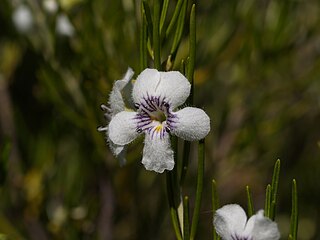
Prostanthera campbellii is a species of flowering plant in the family Lamiaceae and is endemic to the south-west of Western Australia. It is an erect shrub with linear leaves and white to cream-coloured flowers with purple striations.

Prostanthera canaliculata is a species of flowering plant in the family Lamiaceae and is endemic to the south-west of Western Australia. It is a small, erect shrub with hairy branchlets, narrow egg-shaped to narrow elliptical leaves and pale blue or pale violet to white flowers with no markings.

Prostanthera eckersleyana, commonly known as crinkly mintbush, is a species of flowering plant in the family Lamiaceae and is endemic to the south-west of Western Australia. It is an erect or spreading shrub with sticky, hairy branchlets, egg-shaped to elliptical leaves and blue, mauve to purple or violet flowers with maroon spots inside the petal tube.
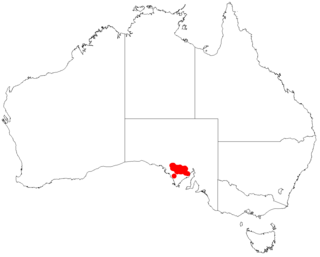
Prostanthera florifera, commonly known as Gawler Ranges mintbush, is a species of flowering plant in the family Lamiaceae and is endemic to the Eyre Peninsula in South Australia. It is a small shrub with densely hairy branches, thick, linear to narrow oblong leaves, and pinkish-red flowers that are pale pink with pinkish-red blotches inside the petal tube.

Prostanthera grylloana is a species of flowering plant in the family Lamiaceae and is endemic to Western Australia. It is a small, erect shrub with densely hairy branchlets, small, spatula-shaped leaves and red to pink flowers.

Prostanthera lanceolata is a species of flowering plant in the family Lamiaceae and is endemic to near-coastal area of eastern Australia. It is an erect, aromatic shrub that has stems that are square in cross-section, glandular, egg-shaped leaves and mauve or deep bluish-purple flowers.

Prostanthera sericea, commonly known as silky mintbush or walyuwalyu, is a species of flowering plant in the family Lamiaceae and is endemic to inland Australia. It is an erect shrub with hairy branches, cylindrical leaves and white flowers with mauve or purple streaks.




















